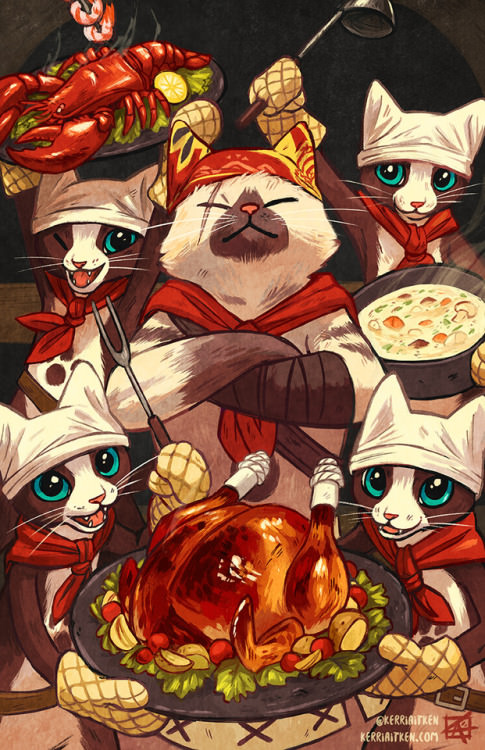
& Snake Wyverns
Table of Contents
-
Lynians
- 2Felyne (CR 1)
- 3Melynx (CR 1)
- 3Wild Melynx (CR 1/8)
- 4Grimalkyne (CR 1)
- 5Shakalaka (CR 1/8)
- 5King Shakalaka (CR 1)
- 6Gajalaka (CR 1/8)
-
Herbivore
- 7Kelbi (CR 0)
- 7Anteka (CR 1/8)
- 8Apceros (CR 1/4)
- 8Aptonoth (CR 1/8)
- 9Popo (CR 1/4)
- 9Slagtoth (CR 1/8)
- 10Epioth (CR 1/8)
- 10Rhenoplos (CR 1/2)
- 11Gargwa (CR 1/4)
- 11Larinoth (CR 1/4)
- 12Gastodon (CR 1)
- 12Kestodon (CR 1/4)
- 13Mosswine (CR 0)
- 13Moofah (CR 0)
-
Snake Wyverns
- 14Remobra (CR 1/4)
- 14Wingdrake (CR 1/8)
- 15Najarala (CR 9)
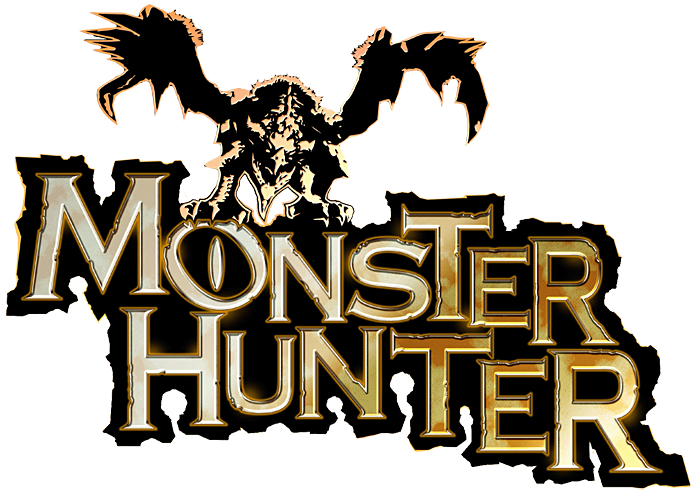
Lynians
Lynians are sapient monsters, and are typically short of stature. There are currently two distinct groups of Lynian: the cat-like Melynx, Felyne, and Grimalkyne, and the humanoid Shakalaka and Gajalaka. Lynians are intelligent, have complex societies, and speak their own languages. Whereas the Shakalaka and Gajalaka are more primitive and tribal, the feline species tend to lead peaceful lives and often coexist with human society.
Felyne
Felynes resemble bipedal cats capable of human language. They typically have light fur, but can come in a variety of colors and patterns.
Felyne are a lot more agile and smarter than an average cat. The Felyne are able to walk upright, like a human, and even build tools with both hands. Felyne are looked at as their own culture due to their intelligence, lifestyle, and groups. They can make equipment such as pickaxes, axes, and bombs. Felyne are known to form villages in secluded areas, where most monsters wouldn't dare to venture to. Felyne villages are known to have tribal exchanges with other Felyne and other cultures. With enough time and practice, Felyne can learn how to talk in the same languages as other cultures, including the human language. However, they often retain a degree of an accent in the form of meowing and cat puns interspersed throughout their speech.
Every Felyne is different in their own way. Some are aggressive, while some are calm. If attacked, however, they'll attack with just about anything in their hand, even going as far as to run at a foe with a live bomb for protection. If the battle starts looking bad, they'll dig a hole and travel somewhere safe. Commonly, Felyne are seen working in all sorts human establishments or settlements. They've been seen being farmers, traders, adventurers, etc. Some Felyne, known as Palicoes, are known to assist hunters- and quite a few are independent "Meownster Hunters" in their own right.
Felyne
Small humanoid (lynian), chaotic good
- Armor Class 15 (chain shirt)
- Hit Points 36 (8d6+8)
- Speed 25 ft., burrow 10 ft.
STR DEX CON INT WIS CHA 14 (+2) 12 (+1) 13 (+1) 9 (-1) 10 (+0) 14 (+2)
- Senses passive Perception 10
- Languages Catonese, Common
- Challenge 1 (200 xp)
Feline Inspiration (2/per long or short rest). As a bonus action, the felyne sounds its horn inspiring a target within 30 feet of it. The target gains an Inspiration die, a d4. Once within the next 10 minutes, the creature can roll the die and add the number rolled to one ability check, attack roll, or saving throw it makes.
Actions
Multiattack The wild felyne makes two bone pick attacks.
Bone Pick. Melee Weapon Attack: +4 to hit, reach 5 ft., one target. Hit: 5 (1d6 + 2) slashing damage.
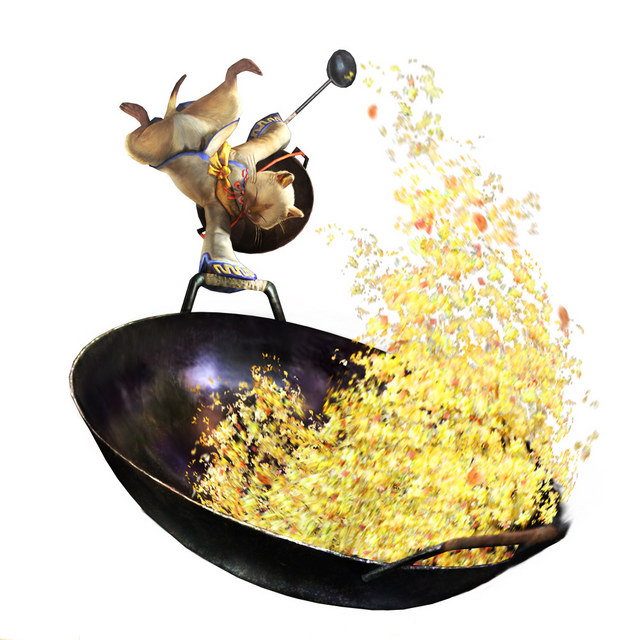
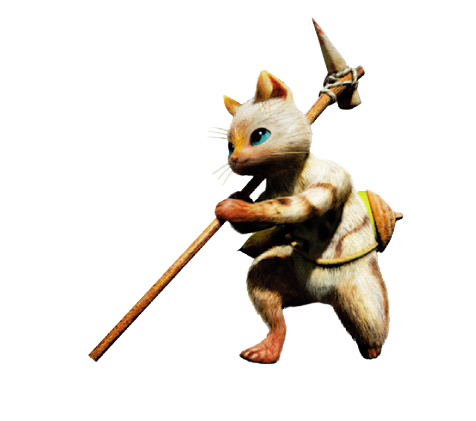
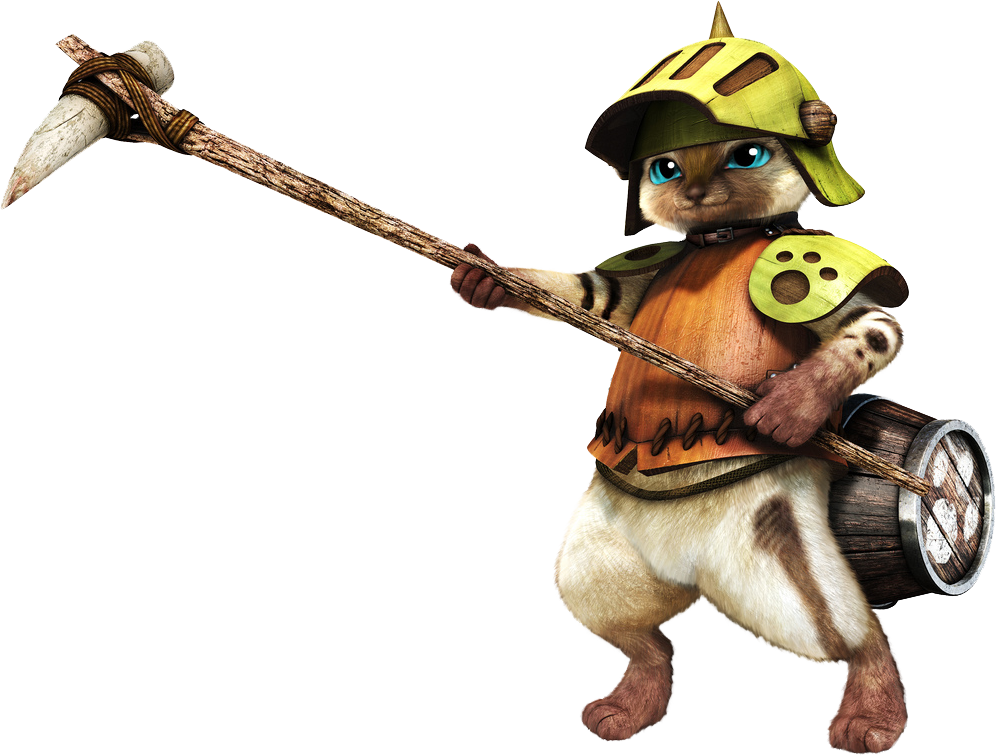
Melynx
Melynx are noted for their black fur and the ability to talk in human language, as well as do human activities like their fellow Lynian subspecies called the Felynes.
Melynx are quite intelligent. Melynx are able to build tools, trade with other Lynian tribes, and even settle in settlements. Melynx in human villages sometimes take job opportunities, mostly as Felyne Chefs and/or Felyne Comrades. Felyne Chefs cook food for their customer to support them in their adventures by temporarily enhancing their abilities. Melynx are quite intelligent.
Wild Melynx appear in groups and have a tendency to rob hunters of their items so they can see how valuable said item is. Once they obtain an item, they run away and dig underground. Secluded, they'll look at the item and consider if its valuable or not. If it is valuable they'll either sell it, trade it, or give it away to another Lynian tribe. If it isn't valuable they may just intentionally leave it behind somewhere random. If items are stolen by a Melynx than there is chance that one could get it back by looking for a crude statue of a Felyne with paint on it. Some items can be recovered here.
They live in harmony with the lighter-toned species of Lynian, the Felynes. The Melynx and Felynes seem to be hostile towards the other Lynian Species, the Shakalaka, as they are never seen living in the same area together, though all three species live in the same environments.
Melynx
Small humanoid (lynian), chaotic good
- Armor Class 13 (chain shirt)
- Hit Points 40 (9d6+9)
- Speed 25 ft., burrow 10 ft.
STR DEX CON INT WIS CHA 16 (+3) 10 (+0) 13 (+1) 8 (-1) 12 (+1) 10 (+0)
- Senses passive Perception 11
- Languages Catonese, Common
- Challenge 1 (200 xp)
Actions
Multiattack The melynx makes two mace attacks.
Catspaw Mace. Melee Weapon Attack: +5 to hit, reach 5 ft., one target. Hit: 6 (1d6 + 3) bludgeoning damage.
Flash Bomb (1/day). The melynx slams a bulb of blinding powder onto the ground in front of it. All creatures within 30 feet of the melynx must make a DC 11 Constitution saving throw or become blinded for 1 minute. A creature may repeat the saving throw at the end of its turns, ending the effect.
Wild Melynx
Small humanoid (lynian), unaligned
- Armor Class 13 (hide)
- Hit Points 26 (8d6)
- Speed 25 ft., burrow 10 ft.
STR DEX CON INT WIS CHA 9 (-1) 12 (+1) 10 (+0) 6 (-3) 10 (+0) 10 (+0)
- Senses passive Perception 10
- Languages Catonese, Common
- Challenge 1/8 (25xp)
Loot. A wild melynx can only hold one stolen item at a time. When its uses its snatch, it will prioritize herbs first, potions second, or any other item of the DMs choice third. It cannot steal anything that weighs more than 9 lbs.
Pilfer. When the wild melynx steals an item, it will use its movement to flee from the target as if it was frightened. Once it is 60 feet away from all enemies, it will burrow underground and travel to its "base."
Actions
Multiattack The wild melynx makes two catspaw mace attacks.
Snatch. The wild melynx attempts to steal an object from its target. The target must make a DC 10 Dexterity saving throw or have an item stolen. A wild melynx will drop the stolen item if it takes 5 damage on a single turn or dies.
Catspaw Mace. Melee Weapon Attack: +1 to hit, reach 5 ft., one target. Hit: 2 (1d6 - 1) bludgeoning damage.
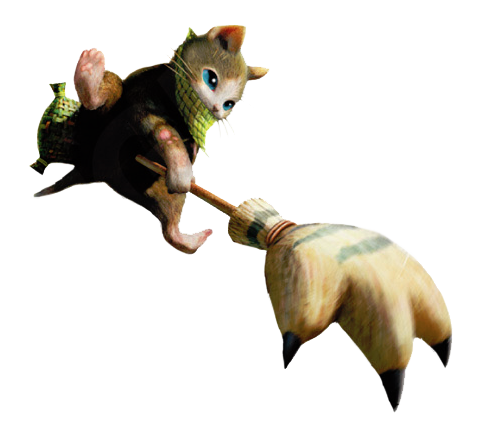
Grimalkyne
Grimalkyne resemble bipedal lynxes. They have tufted ears, and come in a variety of colors depending on the tribe.
Grimalkyne are wary of strangers,[1] but will readily help those who have proven themselves to their tribe. Once befriended, Grimalkyne will share their tools and assist in trapping monsters. They mark their territory with doodles and their dens are usually well hidden.
Grimalkyne
Small humanoid (lynian), neutral
- Armor Class 13 (leather armor)
- Hit Points 55 (10d6+20)
- Speed 25 ft., burrow 10 ft.
STR DEX CON INT WIS CHA 13 (+1) 12 (+1) 14 (+2) 9 (-1) 14 (+2) 10 (+0)
- Senses passive Perception 12
- Languages Catonese, Common
- Challenge 1 (200 xp)
Actions
Multiattack The wild grimalkyne makes two war pick attacks.
War Pick. Melee Weapon Attack: +3 to hit, reach 5 ft., one target. Hit: 5 (1d8 + 1) piercing damage.
Vine Net (recharge 5-6). Ranged Weapon Attack. +4 to hit, range 5/15 ft., one Large or smaller creature. Hit: The target is restrained. A creature can use its action to make a DC 13 Strength check to free itself or another creature in a net, ending the effect on a success. Dealing 5 slashing damage to the net (AC 10) frees the target without harming them and destroys the net.
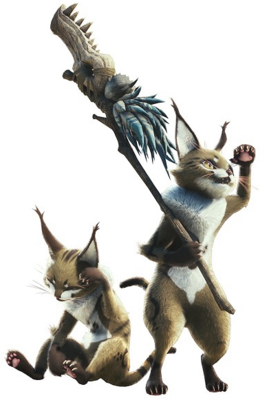
Shakalaka
Shakalaka are small, humanoid creatures with green skin. They wear a mask over their heads at all times, so their true faces are unknown. The Shakalaka are very similar to humans, in that they hunt and gather, but are less civilized in nature.
The Shakalaka have developed strong muscles in order to hunt prey and to attack trespassers. They also have been known to utilize Poison, Sleep Gas, and Barrel Bombs to attack. They also utilize disguises, usually as mushrooms and ice crystals; however, these disguises are easy to see through, as the mushrooms are much larger and brighter than any other, and the ice crystals are metallic colored. Also, it is sometimes possible to see the Shakalaka's mask under its disguise.
The Shakalaka are proud and barbaric creatures, attacking most creatures, including hunters, on sight. It has been said that young Shakalaka partake in a coming-of-age ritual in which they are sent out of their settlement to bring back in item of great value to their tribe. This can take the form of a rare monster material, treasure, or an object with historical or cultural importance to the tribe (such as a special mask).
King Shakalaka
King Shakalaka is slightly larger than its subjects, but generally looks identical. It wears a BBQ spit upon its head, and wields a thighbone as a club. it is surprisingly strong for its size, able to cause a great deal of damage. It is able to launch fireballs from the BBQ spit atop its head.
He can put hunters to sleep, like his Shakalaka brethren, however he appears to have lost the ability to poison hunters. Also, the King Shakalaka has extraordinary endurance which belies its size. Combine this with its muscle power, and it may be assumed that, somehow, it has developed a "berserker-esque" sense which allows it to block out pain, and continue fighting through rigorous physical demands which would have most Shakalaka defeated. To attack, he thoroughly clobbers his foes with a steak from another victim.
The King Shakalaka is an aggressive leader when the Shakalakas fight alongside with him. Its leadership skill came in his bond shared between he and his minions, but the Shakalaka leader relies on teamwork in order to bring down an intruder such as Velociprey and other small sized monsters. This creature shows no sign of fear towards humans. It will harass the intruder who enter its domain with the help of its minions. The creature hates to be provoked by something else. Many secrets about this powerful leader are unknown to many scholars...
Shakalaka
Small humanoid (lynian), neutral
- Armor Class 12
- Hit Points 5 (2d6-2)
- Speed 25 ft.
STR DEX CON INT WIS CHA 15 (+2) 7 (-2) 9 (-1) 8 (-1) 7 (-2) 8 (-1)
- Senses passive Perception 8
- Languages Common, ShakaLaka
- Challenge 1/8 (25 xp)
Pack Tactics. The shakalaka has advantage on an attack roll against a creature if at least one of the shakalaka's allies is within 5 feet of the creature and the ally isn't incapacitated.
Boom Shakalaka. The shakalaka leaves behind a small container when it flees or on its body when it dies. There is a 50 percent chance that the container is actually an explosive that contains no treasure. It is unlocked and requires a DC 12 Wisdom (Investigation) check to determine if it is an explosive. A creature that opens the an explosive container must make a DC 13 Dexterity saving throw, taking 11 (3d6) fire damage on a failed save or half as much on a successful one. A container that is not an explosive contains 11 (3d6) silver pieces worth of materials of the DMs choosing.
Actions
Poison knife. Melee or Ranged Weapon Attack: +4 to hit, reach 5 ft. or range 20/40 ft., one target. Hit: 4 (1d4 + 2) piercing damage and the target must make a DC 10 Constitution saving throw or become poisoned for 1 minute. A creature can repeat the saving throw at the end of each of its turns, ending the effect on itself on a success.
King Shakalaka
Medium humanoid (lynian), neutral
- Armor Class 14 (bone armor)
- Hit Points 42 (6d8+15)
- Speed 25 ft.
STR DEX CON INT WIS CHA 18 (+4) 10 (+0) 16 (+3) 14 (+2) 9 (-1) 8 (-1)
- Senses passive Perception 9
- Languages Common, Shakalaka
- Challenge 1 (200 xp)
Innate Spellcasting. The king shakalaka can innately cast firebolt (+4 to hit with spell attacks), requiring no material components. Its innate spellcasting ability is Intelligence.
Actions
Thighbone. Melee weapon attack +6 to hit, reach 5 ft., one target. Hit: 7 (1d6 + 4) bludgeoning damage.
Sleep Bomb (1/day). The king shakalaka throws a ball of sleep powder at a location within 30 feet of it. All creatures within 10 feet of the location must make a DC 11 Constitution saving throw or fall unconscious for 1 minute, until the sleeper takes damage, or someone uses an action to shake or slap the sleeper awake.
Reactions
Imperial Rage. As a reaction to taking damage, the king shakalaka begins to fight with tyrannical ferocity. For 1 minute, the king shakalaka has resistance to bludgeoning, piercing, and slashing damage, has speed of 35 feet, and has advantage on Strength saving throws. At the end of each of the king shakalaka's turn, the rage ends if the king shakalaka hasn't attacked a hostile creature or taken damage since the end of their last turn.
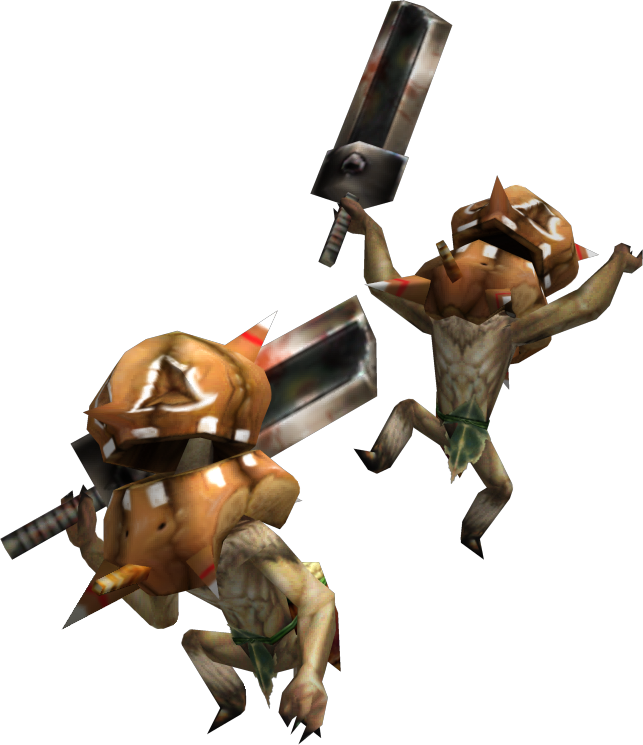
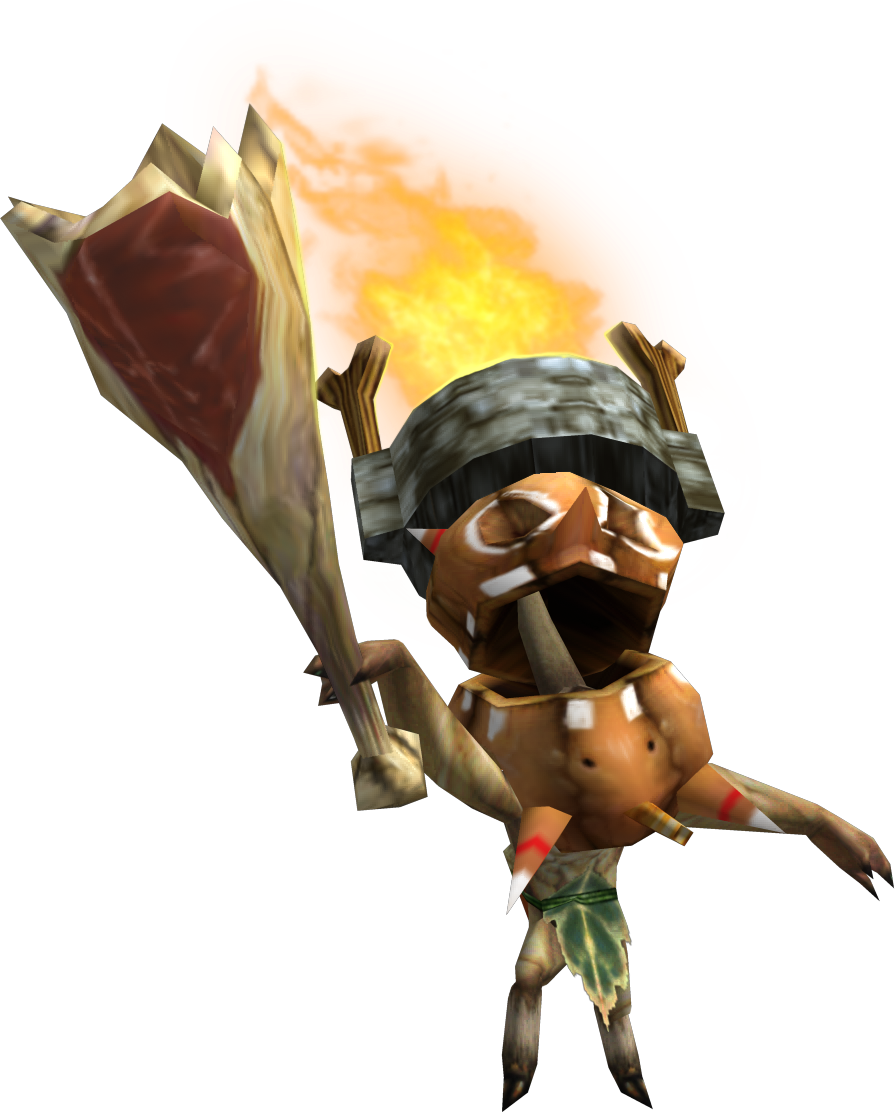
Gajalaka
Small humanoid (lynian), neutral
- Armor Class 12
- Hit Points 5 (2d6-2)
- Speed 25 ft.
STR DEX CON INT WIS CHA 15 (+2) 7 (-2) 9 (-1) 8 (-1) 7 (-2) 8 (-1)
- Senses passive Perception 8
- Languages Common, Shakalaka
- Challenge 1/8 (25 xp)
Tribal Mask The gajalaka wears a red mask. These red masks have different color accents, ranging from blue to yellow to purple to black, to represent what condition their weapons afflict. Roll 1d4, On a 1 blue represents stone knife; On a 2 yellow represents paralysis knife; On a 3 purple represents poison knife; and on a 4 black represents blind knife.
Actions
Stone knife. Melee or Ranged Weapon Attack: +4 to hit, reach 5 ft. or range 20/40 ft., one target. Hit: 4 (1d4 + 2) piercing damage and the target must make a DC 10 Constitution saving throw or become petrified for 1 minute. A creature can repeat the saving throw at the end of each of its turns, ending the effect on itself on a success.
Blind knife. Melee or Ranged Weapon Attack: +4 to hit, reach 5 ft. or range 20/40 ft., one target. Hit: 4 (1d4 + 2) piercing damage and the target must make a DC 10 Constitution saving throw or become blinded for 1 minute. A creature can repeat the saving throw at the end of each of its turns, ending the effect on itself on a success.
Paralysis knife. Melee or Ranged Weapon Attack: +4 to hit, reach 5 ft. or range 20/40 ft., one target. Hit 4 (1d4 + 2) piercing damage and the target must make a DC 10 Constitution saving throw or become paralyzed for 1 minute. A creature can repeat the saving throw at the end of each of its turns, ending the effect on itself on a success.
Sleep knife. Melee or Ranged Weapon Attack: +4 to hit, reach 5 ft. or range 20/40 ft., one target. Hit: 4 (1d4 + 2) piercing damage and the target must make a DC 10 Constitution saving throw fall unconscious for 1 minute, until the sleeper takes damage, or someone uses an action to shake or slap the sleeper awake.
Gajalaka
Like many Lynians, Gajalaka are short humanoids. They resemble Shakalaka more than Felynes or Grimalkynes, lacking any fur and wearing large tribal masks which leave only their bright yellow eyes visible. These red masks have different color accents, ranging from blue to yellow to purple, to represent what status ailment their weapons afflict. The Gajalaka are aggressive towards large monsters and hunters, and will throw projectiles at both.
The Gajalaka are aggressive towards large monsters and adventurerers, and will attack with status-afflicting weapons if threatened. The Gajalaka are capable of dealing Sleep, Paralysis, and Poison to both large monsters and players alike. You can tell these apart by the color of their mask's accents; blue represents sleep, yellow represents paralysis, and purple represents poison. Gakalaka can accidentally poison each other if they get crossed up in skirmishes.
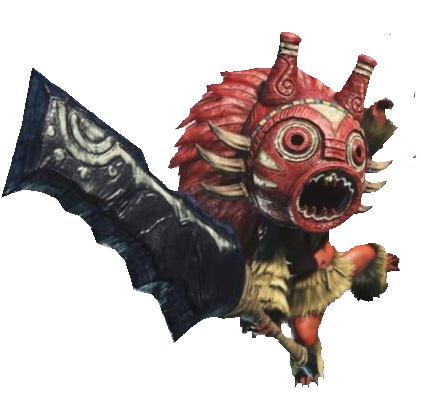
Herbivore
Herbivores are minor creatures that eat vegetation. While there are herbivorous creatures in other classes, such as Diablos and Duramboros, monsters in the Herbivore class are usually docile, reside at the bottom of the food chain, and therefore pose little threat to a adventurer.
Kelbi
Kelbi are very fleet of foot. They can travel at great speeds over long distances, due in part to their light frame. Kelbi have a green/brown spotted coat that serves as camouflage in their forest homes. Kelbi's most notable feature is its horn, prized by hunters for its ability to create powerful herbal medicines and potions. Male Kelbi are larger than females and have bigger horns, as well as being more brightly colored with a greenish coat. Males will also grow a beard. Female Kelbi are smaller, possess smaller horns and have a darker, slightly blue, coat.
Kelbi
Medium beast, unaligned
- Armor Class 10
- Hit Points 4 (1d8)
- Speed 30 ft.
STR DEX CON INT WIS CHA 11 (+0) 10 (+0) 12 (+1) 2 (-4) 10 (+0) 5 (-3)
- Senses passive Perception 10
- Languages -
- Challenge 0 (10 xp)
Sure-Footed. The kelbi has advantage on Strength and Dexterity saving throws made against effects that would knock it prone.
Actions
Ram. Melee Weapon Attack: +2 to hit, reach 5 ft., one target. Hit: 2 (1d4) bludgeoning damage.
Anteka
Anteka are greatly adapted for life in the cold. They have long legs with thick, cloven hooves, excellent for bursts of speed as well as keeping the creature from sinking in the snow. Anteka also have thick, wooly fur that shields it from the frigid mountain air. Anteka are known for their large horns. They are present in both genders.
Anteka
Medium beast, unaligned
- Armor Class 11
- Hit Points 5 (1d8+1)
- Speed 30 ft.
STR DEX CON INT WIS CHA 13 (+1) 10 (+0) 12 (+1) 2 (-4) 10 (+0) 5 (-3)
- Damage Immunities cold
- Senses passive Perception 10
- Languages -
- Challenge 1/8 (25 xp)
Charge. If the anteka moves at least 20 feet straight toward a target and then hits it with a ram attack on the same turn, the target takes an extra 2 (1d4) bludgeoning damage. If the target is a creature, it must succeed on a DC 10 Strength saving throw or be knocked prone.
Ice Walk. The dragon can move across and climb icy surfaces without needing to make an ability check. Additionally, difficult terrain composed of ice or snow doesn't cost it extra moment.
Actions
Ram. Melee Weapon Attack: +3 to hit, reach 5 ft., one target. Hit: 3 (1d4 + 1) bludgeoning damage.
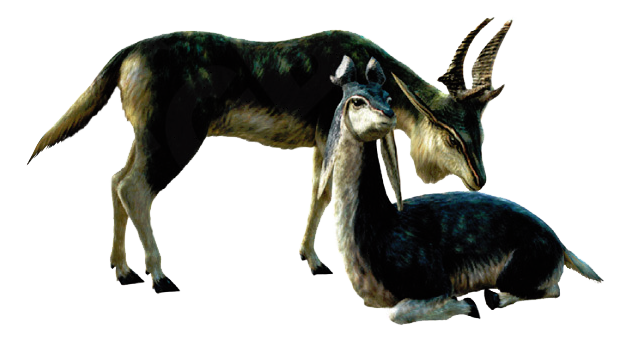
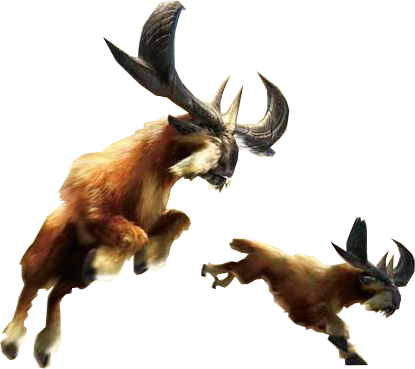
Apceros
Apceros are herbivorous reptiles that frequent desert and volcanic areas. They have a body structure similar to Aptonoth, their evolutionary cousins. They have many characteristics of tortoises, such as head shape and protective shell. Their tails have a developed mace-like structure on the end that is covered with sharp spikes.
Apceros are territorial monsters and will attack any intruder on sight. They will not give up fighting until the enemy has fallen or they are dead. Curiously, they work in small herds to take out any threats. They appear not to care if a large monster is in the area.
Apceros
Large beast, unaligned
- Armor Class 13 (natural armor)
- Hit Points 19 (3d10+3)
- Speed 30 ft.
STR DEX CON INT WIS CHA 14 (+2) 10 (+0) 12 (+1) 2 (-4) 9 (-1) 5 (-3)
- Senses passive Perception 9
- Languages -
- Challenge 1/4 (25xp)
Actions
Headbutt. Melee Weapon Attack: +4 to hit, reach 5 ft., one target. Hit: 5 (1d6 + 2) bludgeoning damage.
Tail. Melee Weapon Attack: +4 to hit, reach 5 ft., one target. Hit: 6 (1d8 + 2) slashing damage.
Aptonoth
Aptonoth are cow-like creatures with leathery gray skin. They have black stripes along their backs and a head reminiscent of a Hadrosaur. They have a large, two-pronged crest protruding from their heads and a flat, spiked tail.
These docile creatures are hunted for their meat by humans and other monsters. They always travel in groups. When one Aptonoth is threatened, others will run away for safety, but sometimes the alpha male of the Aptonoth will attempt to fight back before fleeing himself. Sometimes the fleeing Aptonoth will walk over the River in Forest & Hills Area 1, probably to return back to their herd.
Aptonoth
Large beast, unaligned
- Armor Class 12 (natural armor)
- Hit Points 26 (4d10+4)
- Speed 30 ft.
STR DEX CON INT WIS CHA 12 (+1) 10 (+0) 13 (+1) 1 (-5) 8 (-1) 5 (-3)
- Senses passive Perception 8
- Languages -
- Challenge 1/8 (25xp)
Actions
Headbutt. Melee Weapon Attack: +3 to hit, reach 5 ft., one target. Hit: 4 (1d6 + 1) bludgeoning damage.
Tail. Melee Weapon Attack: +3 to hit, reach 5 ft., one target. Hit: 5 (1d8 + 1) slashing damage.
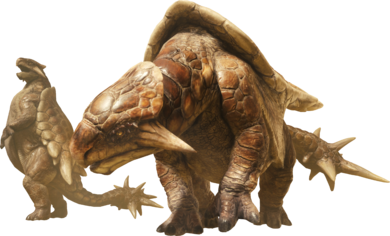
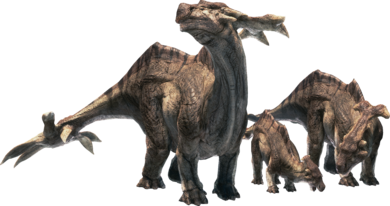
Popo
A large grazing herbivore, Popo is somewhat easy prey for anything larger than itself. Its size and tusks only work to deter smaller predators. Popo are very docile creatures and will run when one of their members in a group is under attack or when a threat enters their area. They will also group together when a large monster is near, like the Aptonoth in more temperate climates.
Popo
Large beast, unaligned
- Armor Class 11
- Hit Points 6 (1d10+1)
- Speed 20 ft.
STR DEX CON INT WIS CHA 13 (+1) 8 (-1) 12 (+1) 3 (-4) 11 (+0) 6 (-2)
- Senses passive Perception 10
- Languages -
- Challenge 1/4 (50 xp)
Trampling Charge. If the popo moves at least 20 feet straight toward a creature and then hits it with a gore attack on the same turn , that target must succeed on a DC 10 Strength saving throw or be knocked prone. If the target is prone, the popo can make one stomp attack against it as a bonus action.
Actions
Multiattack. The popo makes one gore attack and one stomp attack.
Gore. Melee Weapon Attack: +3 to hit, reach 5 ft., one target. Hit: 4 (1d6 + 1) piercing damage.
Stomp. Melee Weapon Attack: +3 to hit, reach 5 ft., one target. Hit: 3 (1d4 + 1) bludgeoning damage.
Slagtoth
Large beast, unaligned
- Armor Class 12
- Hit Points 11 (2d10)
- Speed 30 ft.
STR DEX CON INT WIS CHA 12 (+1) 8 (-1) 10 (+0) 2 (-4) 11 (+0) 6 (-2)
- Senses passive Perception 10
- Languages -
- Challenge 1/8 (50 xp)
Trampling Charge. If the slagtoth moves at least 20 feet straight toward a creature and then hits it with a body slam attack on the same turn , that target must succeed on a DC 10 Strength saving throw or be knocked prone. If the target is prone, the slagtoth can make one headbutt attack against it as a bonus action.
Actions
Headbutt. Melee Weapon Attack: +3 to hit, reach 5 ft., one target. Hit: 4 (1d6 + 1) bludgeoning damage.
Body Slam. Melee Weapon Attack: +3 to hit, reach 5 ft., one target. Hit: 3 (1d4 + 1) bludgeoning damage.
Slagtoth
Slagtoth have green, saggy hides covering most of their body, most notably drooping near the sides of the head and along their flanks. They are extremely territorial; the males will attack both Adventurers and creatures. They attack Hunters by ramming with the bone lump on their snouts and body-slamming. When unprovoked however, these docile creatures have often been observed to rest in the waters probably because their floppy, frog-like hides require moisture.
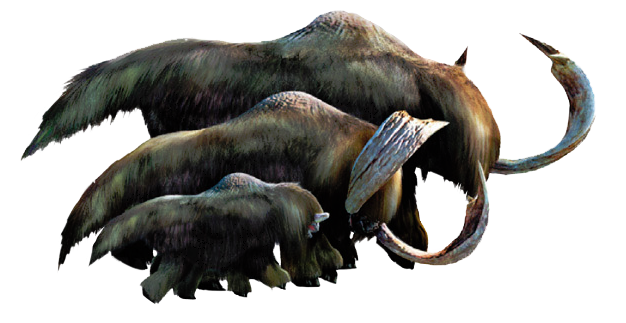
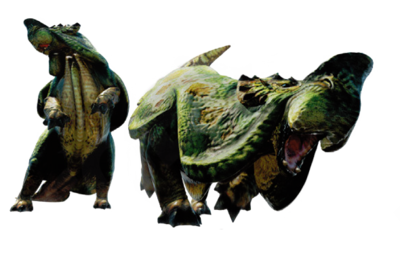
Epioth
Large beast, unaligned
- Armor Class 11
- Hit Points 5 (1d10)
- Speed 0 ft., swim 30 ft.
STR DEX CON INT WIS CHA 12 (+1) 13 (+1) 11 (+0) 2 (-4) 12 (+1) 5 (-3)
- Senses passive Perception 11
- Languages -
- Challenge 1/8 (25 xp)
Charge. If the epioth moves at least 20 feet straight toward a target and then hits it with a ram attack on the same turn, the target takes an extra 2 (1d4) bludgeoning damage. If the target is a creature, it must succeed on a DC 10 Strength saving throw or be knocked prone.
Water Breathing. The epioth can breathe only underwater.
Actions
Ram. Melee Weapon Attack: +3 to hit, reach 5 ft., one target. Hit: 2 (1d4) bludgeoning damage.
Tail. Melee Weapon Attack: +3 to hit, reach 5 ft., one target. Hit: 3 (1d6) bludgeoning damage.
Epioth
The Epioth is described as a marine version of the land dwelling Aptonoth, as both are very low in the food chain. They feed mainly on weeds, water grasses, and algae. They have specialized hides used for their aquatic home, making them perfectly adapted to an aquatic environment. Epioth have finned feet and a fin on their tail, which allows them to swim through water gracefully. When frightened, Epioth can swim at breakneck speeds. Unlike the Aptonoth, Epioth live in small groups rather than large herds. The reason for this is that the water, whether in the sea or jungle river, has abundant hiding places. They are relatively docile when a adventurer is around, but they will defend themselves when a adventurer attacks. Occasionally, Epioth are known to sunbath on land.
Rhenoplos
Rhenoplos is a quadrupedal, Ceratopsian-like monster with an armored body. Its face features a small nose horn and is surrounded by a frill. While the eyes of Rhenoplos are not particularly proficient, their hearing is. Rhenoplos charge blindly at whatever sound startles them, including large monsters. However, this makes them easy to dodge and easy prey for predators placing them near the bottom of the food chain with most other herbivores. These creatures live in small groups, spending most of their days traversing the hot environments while foraging for shrubs and other plant matter.
Rhenoplos
Medium beast, unaligned
- Armor Class 14
- Hit Points 45 (7d8+14)
- Speed 40 ft.
STR DEX CON INT WIS CHA 19 (+4) 8 (-1) 15 (+2) 2 (-4) 12 (+1) 5 (-3)
- Senses passive Perception 11
- Languages -
- Challenge 2 (450 xp)
Charge. If the rhenoplos moves at least 20 feet straight toward a target and then hits it with a ram attack on the same turn, the target takes an extra 9 (2d8) bludgeoning damage. If the target is a creature, it must succeed on a DC 14 Strength saving throw or be knocked prone.
Keen Hearing. The rhenoplos has advantage on Wisdom (Perception) checks that rely on hearing.
Actions
Ram. Melee Weapon Attack: +6 to hit, reach 5 ft., one target. Hit: 13 (2d8 + 4) bludgeoning damage.
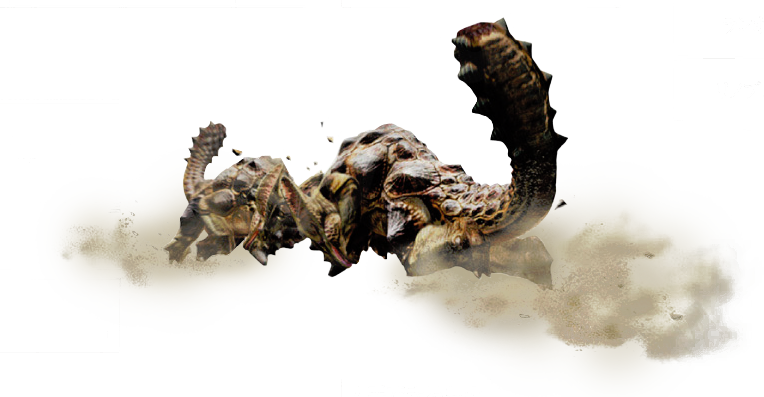
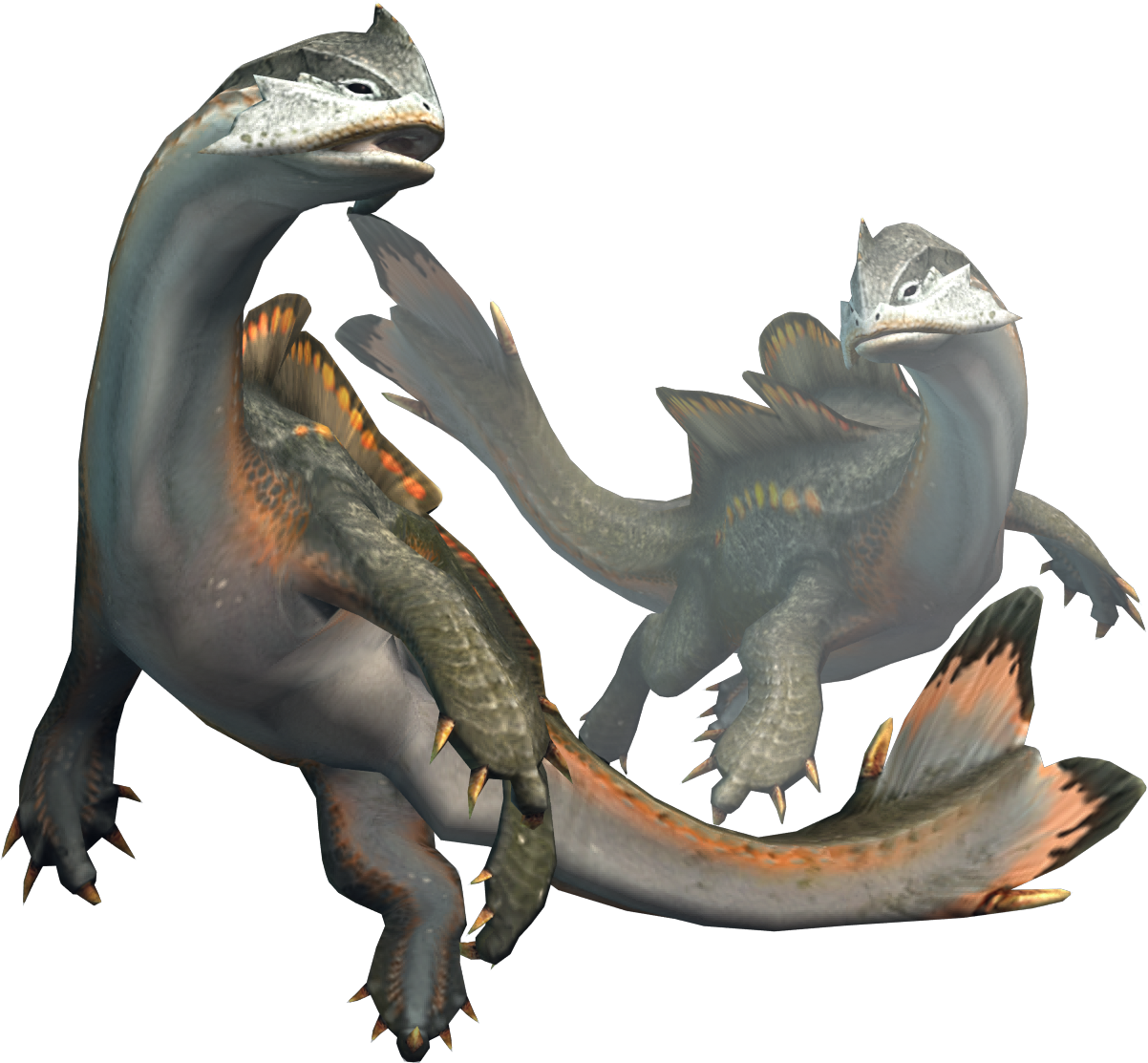
Gargwa
Gargwa have very small, likely vestigial wings. Like most species of Herbivore, they're normally docile creatures, but will attack and flee when they're threatened and when they flee will usually leave an egg or guano. They coexist with the people as livestock, but they have been known to attack Adventurers from time to time.
Gargwa
Large beast, unaligned
- Armor Class 12
- Hit Points 26 (4d10+4)
- Speed 30 ft.
STR DEX CON INT WIS CHA 15 (+2) 11 (+0) 12 (+1) 2 (-4) 10 (+0) 5 (-3)
- Senses passive Perception 10
- Languages -
- Challenge 1/4 (25 xp)
Actions
Beak. Melee Weapon Attack: +4 to hit, reach 5 ft., one target. Hit: 6 (1d8 + 2) piercing damage.
Larinoth
Larinoth are quite huge monsters, compared to other herbivores and even many large monsters. It possesses a great height, which is mostly attributed to its extremely lengthy neck. The tail of a Larinoth is rounded and club-like, with spiked plating that runs along the back and up to the crest on its head. Said plating is nearly entirely green, and the Larinoth's underbelly is a cream color.
Larinoth
Huge beast, unaligned
- Armor Class 14
- Hit Points 19 (3d12)
- Speed 30 ft.
STR DEX CON INT WIS CHA 12 (+1) 10 (+0) 11 (+0) 2 (-4) 10 (+0) 5 (-3)
- Senses passive Perception 10
- Languages -
- Challenge 1/4 (50 xp)
Actions
Stomp. Melee Weapon Attack: +3 to hit, reach 5 ft., one target. Hit: 8 (3d4 + 1) bludgeoning damage.
Tail. Melee Weapon Attack: +3 to hit, reach 5 ft., one target. Hit: 5 (1d8 + 1) bludgeoning damage.
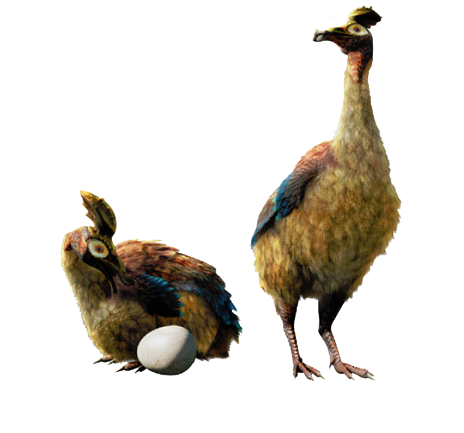
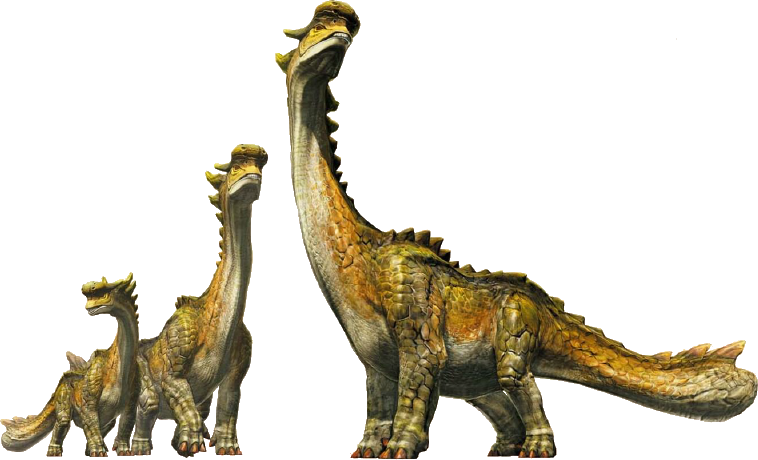
Gastodon
Medium beast, unaligned
- Armor Class 13
- Hit Points 13 (2d8+4)
- Speed 40 ft.
STR DEX CON INT WIS CHA 16 (+3) 10 (+0) 14 (+2) 2 (-4) 10 (+0) 6 (-2)
- Senses passive Perception 10
- Languages -
- Challenge 1 (200 xp)
Charge. If the gastodon moves at least 20 feet straight toward a target and then hits it with a ram attack on the same turn, the target takes an extra 5 (2d4) damage. If the target is a creature, it must succeed on a DC 13 Strength saving throw or be knocked prone.
Actions
Ram. Melee Weapon Attack: +5 to hit, reach 5 ft., one target. Hit: 8 (2d4 + 3) bludgeoning damage.
Kestodon
Medium beast, unaligned
- Armor Class 14
- Hit Points 19 (3d8+6)
- Speed 40 ft.
STR DEX CON INT WIS CHA 15 (+2) 11 (+0) 14 (+2) 2 (-4) 12 (+1) 5 (-3)
- Saving throws Str +4
- Senses passive Perception 11
- Languages -
- Challenge 1/4 (50 xp)
Charge. If the kestodon moves at least 20 feet straight toward a target and then hits it with a ram attack on the same turn, the target takes an extra 2 (1d4) damage. If the target is a creature, it must succeed on a DC 12 Strength saving throw or be knocked prone.
Actions
Ram. Melee Weapon Attack: +4 to hit, reach 5 ft., one target. Hit: 5 (1d4 + 3) bludgeoning damage.
Gastodon
Gastodon resembles a cross between a theropod and a bison. It is covered in scales but has a large furry mane and horns reminiscent of a bison. When angered, it will glow red. They are very aggressive towards adventurers, and are willing to attack larger monsters as a herd.
Kestodon
Kestodon has an appearance similar to a Pachycephalosaurus. The male Kestodon are bright orange in color and have a large head crest, which is used for headbutting rivals. Female Kestodon are bronze in color though lack the head crest found in males. Kestodon are a calm species that will turn aggressive once attacked by a threat.
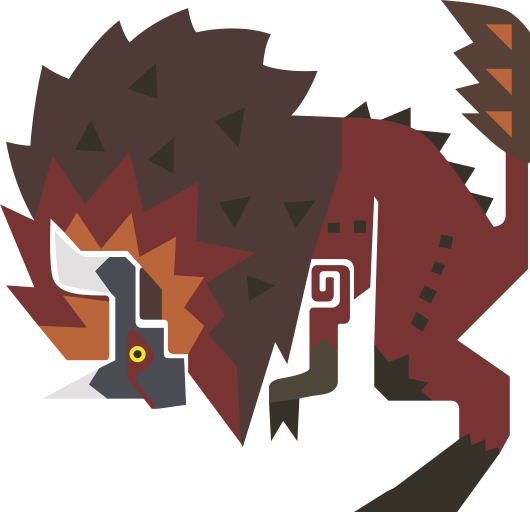
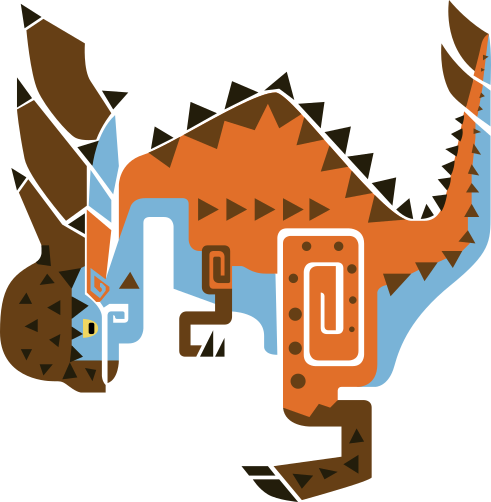
Mosswine
Mosswine are small, moss-covered pigs. They have a gray, spiky head plate. Mosswine are known to have a great appetite for mushrooms. Hunters and marketers commonly observe them to identify an area of Special Mushrooms. Mosswine are docile by nature, but will attack if provoked. They are mostly hunted for their mushroom-tracking abilities and their meat.
Mosswine
Medium beast, unaligned
- Armor Class 10
- Hit Points 5 (1d8+1)
- Speed 30 ft.
STR DEX CON INT WIS CHA 11 (+0) 11 (+0) 12 (+2) 2 (-4) 9 (-1) 5 (-3)
- Senses passive Perception 9
- Languages -
- Challenge 0 (10 xp)
Mushroom Hunter. The mosswine advantage on any Wisdom (Perception) checks that rely on smell when hunting mushrooms.
Actions
Ram. Melee Weapon Attack: +2 to hit, reach 5 ft., one target. Hit: 2 (1d4) bludgeoning damage.
Moofa
Moofah are docile alpaca-like creatures known for their long shaggy fur. Males have longer horns than females. Domesticated Moofah have lighter-colored fur than their wild counterparts, and wear colored bows and bells.
Moofah
Small beast, unaligned
- Armor Class 10
- Hit Points 3 (1d6)
- Speed 30 ft.
STR DEX CON INT WIS CHA 10 (+0) 10 (+0) 11 (+0) 2 (-4) 10 (+0) 5 (-3)
- Senses passive Perception 10
- Languages -
- Challenge 0 (10 xp)
Sure-Footed. The moofah has advantage on Strength and Dexterity saving throws made against effects that would knock it prone.
Actions
Headbutt. Melee Weapon Attack: +2 to hit, reach 5 ft., one target. Hit: 2 (1d4) bludgeoning damage.
Snake Wyverns
Snake Wyverns are a class of monster known for their serpentine features, such as long, coiling bodies and forked tongues. They can range dramatically in both size and overall body structure, with some members being large, serpentine land-dwellers, while others are smaller and more reminiscent of Flying Wyverns.
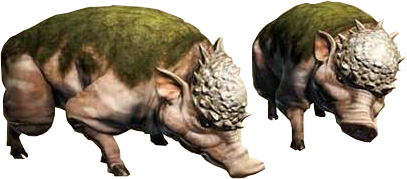
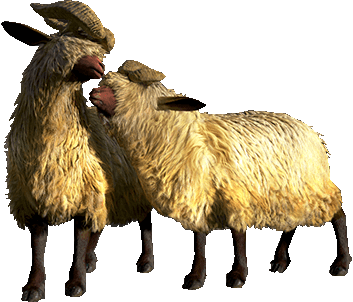
Remobra
Remobra are classified as Flying Wyverns in the Old World but, have recently been reclassified as Snake Wyverns. The Remobra have evolved wings, which are fairly large in comparison to their body size in the Old World. Despite their wings being large, their legs are relatively weak and they can barely stand up with their legs. To avoid standing up, they spend of their time in the air flying. It preys upon weakened animals, by using their poison to finish off their victim and letting it bleed to death.
Remobra
Medium wyvern (snake), unaligned
- Armor Class 13
- Hit Points 33 (6d8+6)
- Speed 10 ft., fly 40 ft.
STR DEX CON INT WIS CHA 14 (+2) 11 (+0) 12 (+1) 3 (-4) 12 (+1) 6 (-2)
- Senses passive Perception 10
- Languages -
- Challenge 1/2 (100 xp)
Actions
Multiattack. The remobra makes two tail attacks.
Tail. Melee Weapon Attack: +4 to hit, reach 10 ft., one target. Hit: 5 (1d6 + 2) bludgeoning damage.
Poison Spit. Range Weapon Attack: +4 to hit, range 30/120 ft., one target. Hit: 9 (2d8) poison damage.
Wingdrake
Wingdrakes that somewhat resemble certain species based on their environment. Wingdrakes from forests resemble certain species of rhamphorhynchoid pterosaur. They have parrot-like beaks, blue skin, and a long yellow-tipped tail. While wingdrakes of the desert resemble vultures in addition to pterosaurs. They have a large beak, a waddle hanging from their neck, light-brown skin, and a long tail. Others in a coral landscape resemble parrots or tapejarid pterosaurs. They have a light pink skin and wings with ribbon-like appendages hanging from them. In most other environments they resemble retro-style pterosaurs. They have pointed beaks filled with teeth and large draconic wings.
They are typically peaceful towards adventurers, and roam the skies landing only to rest. They live in small flocks, and if one individual goes somewhere, the others will follow. They are commonly used as beasts-of-burden by adventurers for traveling quickly.
Wingdrake
Medium wyvern (snake), unaligned
- Armor Class 10
- Hit Points 6 (1d8+2)
- Speed 10 ft., fly 40 ft.
STR DEX CON INT WIS CHA 14 (+2) 11 (+0) 12 (+1) 3 (-4) 8 (-1) 6 (-2)
- Senses passive Perception 9
- Languages -
- Challenge 1/8 (25 xp)
Flyby. The wingdrake doesn't provoke an opportunity attack when it flies out of an enemy's reach.
Beast of Burden. The wingdrake has the same carrying capacity as a mule (480 lbs) when the cargo is tied to it by a rope or vine.
Actions
Bite. Melee Weapon Attack: +4 to hit, reach 5 ft., one target. Hit: 5 (1d6 + 2) piercing damage.
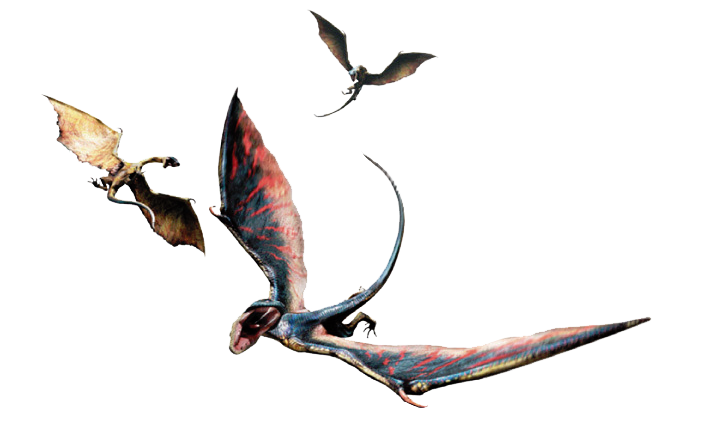
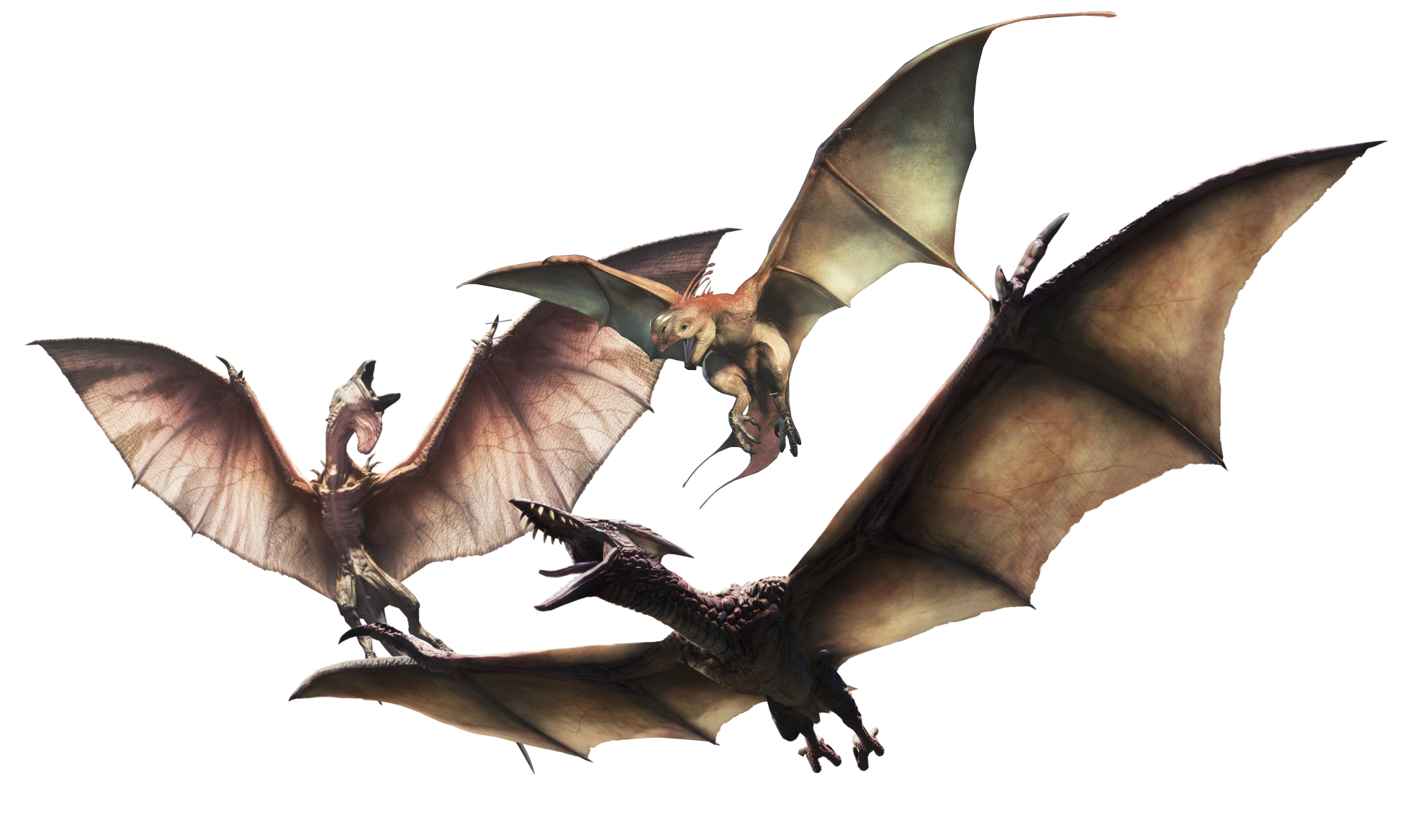
Najarala
Najarala is a large Snake Wyvern with bright green skin adorned with large orange-yellow plates on its back and tail. It has a long serpentine body with small though fully functional fore- and hindlimbs that aid it in moving around on uneven ground. Najarala are stealthy hunters that ruthlessly ambush their targets. It has a large beak-like mouth similar to that of a parrot. This beak is used to rip chunks of flesh from its prey and then swallow said chunks whole. While feeding on prey, it will use its arms to hold on to its prey while ripping off chunks of flesh.
The length of a Najarala surpasses some of the largest leviathans such as Agnaktor or Lagiacrus. As many would notice these creatures have short, yet powerful arms and legs. At first glance these limbs appear to be useless but in reality they enable the creatures to support itself when rearing up. Another fascinating feature is that the creature has a specialized organ on its back that is vibrated by air and creates unique sound waves. This auditory organ has a biological effect in the surrounding area. Najarala have beautiful plates on both its neck and tail that will rattle when upset, giving unwelcome creatures an early warning. The plates on its tail can be thrown at its enemies and will explode creating a loud burst of sound like a sonic bomb. This will stun both prey and enemies alike.
Najarala
Gargantuan wyvern (snake), unaligned
- Armor Class 16 (natural armor)
- Hit Points 159 (11d20 + 44)
- Speed 50 ft., burrow 50 ft., climb 50 ft.
STR DEX CON INT WIS CHA 14 (+2) 20 (+5) 19 (+4) 10 (+0) 14 (+2) 9 (-1)
- Saving Throws Wis +6 Cha +3
- Skills Perception +10, Stealth +9
- Damage Immunities poison
- Condition Immunities poisoned
- Senses blindsight 60 ft., darkvision 120 ft., passive Perception 20
- Languages -
- Challenge 9 (5,000 xp)
Magic Resistance. The najarala has advantage on saving throws against spells and other magical effects.
Surround. The najarala can freely enter a large or smaller creatures space. If the creature is within the inner space of the najarala it is surrounded. A surrounded creature is trapped (escape DC 17) by the najarala's body. A creature can also escape by flying or burrowing out of the area.
Squeeze. As a bonus action, the najarala can use its constrict against a grappled creature or one within the najarala's space.
Actions
Multiattack. The najarala makes two attacks: one with its bite and one with its tail. It can't make both attacks against the same target. Or it makes two sonic scale attacks.
Beak. Melee Weapon Attack. +9 to hit, reach 10 ft., one target. Hit 23 (4d8 + 5) piercing damage, and the target must make a DC 16 Constitution saving throw, or become paralyzed for 1 minute. The target can repeat the saving throw at the end of each of its turns, ending the effect on itself on a success.
Tail. Melee Weapon Attack. +9 to hit, reach 15 ft., one target. Hit 27 (4d10 + 5) bludgeoning damage.
Constrict. Melee Weapon Attack: +7 to hit, reach 0 ft., one creature. Hit: 20 (4d8 + 2) bludgeoning damage, and the target is grappled (escape DC 16). Until this grapple ends, the creature is restrained, and the najarala can't constrict another target.
Sonic Scale. Range Weapon Attack. +9 to hit, range 80/320 ft., one target. Hit 19 (4d6 + 5) force damage and the target must make a DC 16 Constitution saving throw or become deafened for 1 minute.
Sonic Blast (Recharge 5-6). The najarala exhales a blast of force in a 90-line. Each creature in the line must make a DC 16 Dexterity saving throw, taking 39 (11d6) force damage on a failed save, or half as much damage on a successful one.
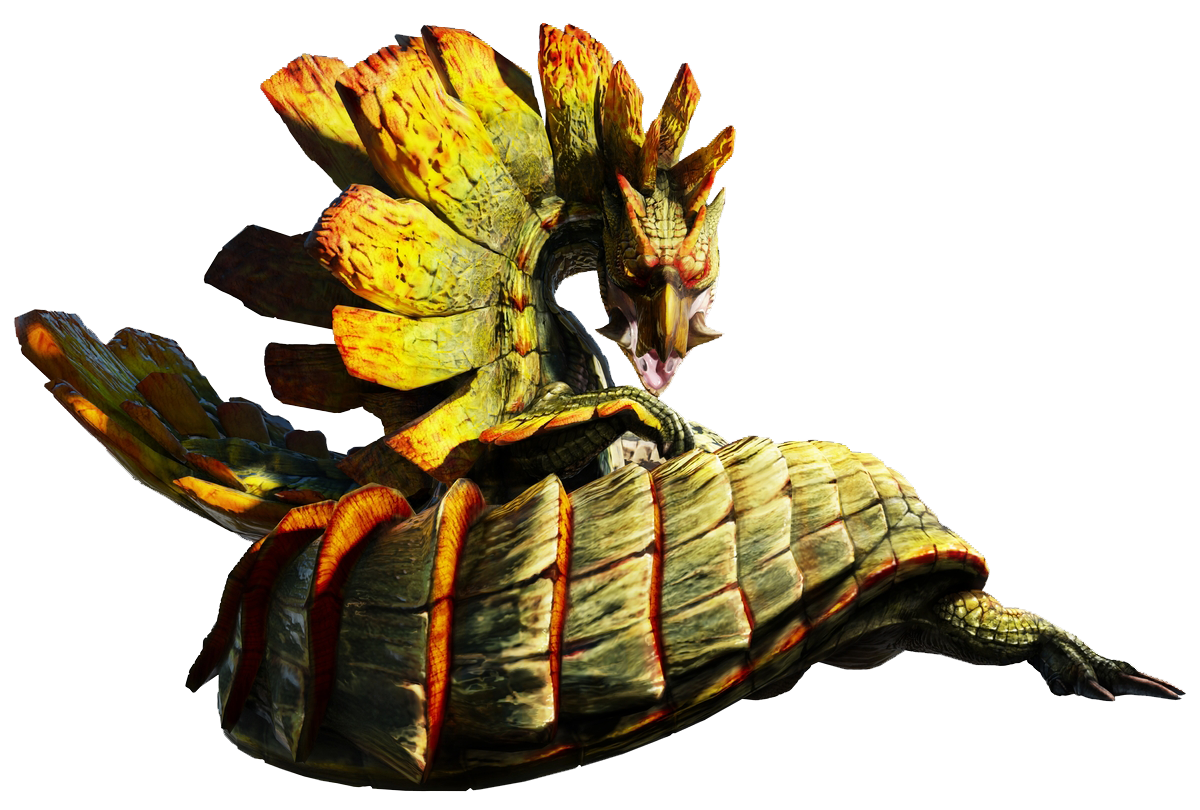

Thank you
For
Checking this out
Thank you all for using this Monster hunter Monster Manual. I created a few monsters originally because I wanted to use them in my own campaign and progressed into this Monster Manual we have today.
This section is 15 pages of monsters from the series and I am pretty proud to say I created them. I hope you all enjoy using these creatures as much as I plan too and this is not the end.
The Monster Manual might be done, but thanks to a few ideas from users on Reddit. I plan on creating a compendium with loot tables for materials, all of the weapons from the videogame series, and rules for using these monsters in your own Monster Hunter D&D game.
If you are interested in letting me know what you think. Feel free to stop by my Twitch channel or check out my Patreon. Thank you for reading and I hope this book serves you well.
Art
Most art, except the cover art, has been gathered from https://monsterhunter.wikia.com website and edited if needed to fit the page. The few others are listed below.
Lore
Most Lore, about these monsters, was also gathered from https://monsterhunter.wikia.com and then edited to omit any mention of missing skills and make the lore more in line with a D&D setting.